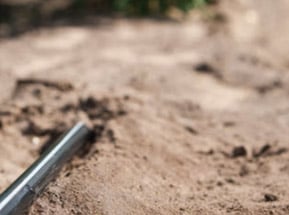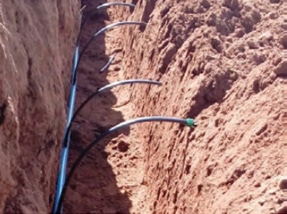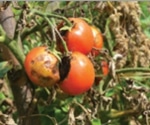
Getting Started with Subsurface Drip Irrigation (SDI)
As the name suggests, subsurface drip irrigation, or SDI for short, is drip irrigation applied underground.
There are two forms of SDI: Shallow and Deep.
Shallow Burial: Refers to the burial of the drip line/tape a few centimetres below the surface. This allows growers to achieve many of the benefits of subsurface irrigation while preventing the thin tube from being blown by the wind. The drip line/tape is intended to be removed and disposed of after the season. Each season, new drip line/tape is installed so growers use the thinnest drip line/tape possible for the environmental conditions to reduce costs. Often the drip line/tape is installed under plastic mulch and installed at the same time as the mulch. This SDI method is often used with single season vegetables, strawberries, and melons.

Deep Burial: Refers to the burial of the drip line/tape at least 10 cm (4”) below the surface. The goal of deep burial is multi-season use with the same drip line/tape being used from a few years to over 20 years. The burial is generally 10 – 30 cm (4 – 12”) with thicker drip line/tape (minimum 12 mil and up to 45 mil) used to ensure that the product will properly function for many years. Additionally, pressure compensated (PC) drip lines may be used to achieve extra-long run lengths, or to irrigate on sloping ground. This SDI method has a wide range of crop applications including cane, corn, cotton, vineyards, tomatoes, orchards and alfalfa. Additionally, deep burial can provide an excellent solution for crop rotation.
Many of the benefits of Subsurface Drip Irrigation apply to both shallow and deep burial; however, the focus of this blog is deep burial applications due to the unique requirements when designing a multi-year irrigation system.
Why Switch to SDI?
We are going to say it upfront. SDI will cost more and be more complicated to install than most other drip irrigation systems to start. However, there is a clear reason why more and more growers are switching to SDI: they realize the benefits quickly outweigh any of the initial challenges. Upfront cost is higher, but long term savings, combined with greater yields, make SDI an excellent long-term financial decision.
“I can’t afford not to use subsurface drip irrigation.” Said Mr.Chuck Dees Irrigation Consultant for Stamoules Product Company, growing over 6500 hectares of crops. USA
Below are some of the long term benefits you will experience using SDI:
Save Water: No Evaporation
Irrigation applied underground eliminates surface water evaporation. Compared to evaporation as high as 45% with sprinkler irrigation (Measurements of evaporation during sprinkler irrigation, University of Southern Queensland, 2012)
Minimize Weeds
By applying water directly to the plants no water is being applied to the interrow. Less water in the interrows or on the surface means fewer weeds, and less costs (herbicides) to eradicate the weeds.
Stronger Root Structure
When a drip lateral is buried 30 cm, roots need to ‘chase’ the water. This leads to a very healthy root structure that penetrates deep into the ground as opposed to concentrating on the surface.
Apply chemigation direct to the root zone – fertilizers, herbicides, insecticides, fungicides
Fertilizers, insecticides and fungicides are a critical (and expensive) part of growing a successful crop. SDI improves the application of chemigation and reduces total costs. Using SDI, chemigation is injected into the drip irrigation system and is applied directly to the root zone. Application is extremely efficient and targeted with 90% efficiency and in some cases, even up to 97% efficiency can be achieved (Economic Feasibility of Converting Center Pivot Irrigation to Subsurface Drip Irrigation, American Society of Farm Managers & Rural Appraisers, 2016). What method of spray chemigation can reach uniformity of >90% consistency? Also, unlike spray irrigation, you do not need to worry about wind restrictions. With increased and targeted uniformity, there is a clear cost benefit as less chemigation is required for application. Additionally, when you apply directly via your drip system, you do not need to use a tractor and avoid all of the associated costs of fuel, labor and machinery.
Reduce Plant Disease
A noticeable difference of SDI is that while the plants are irrigated, the top soil remains relatively dry. Compared to sprinkler irrigation, or even surface drip irrigation, SDI enables you to irrigate right up to harvest. Furthermore, a drier surface results in less humidity and therefore less risk of fungal disease.
Easy Field Access and Harvest
When drip laterals are buried, field access is easy as SDI eliminates the need for irrigation pipes on the surface. For harvesting of nuts where mechanical sweepers are used, any irrigation on surface can be a problem. This problem is eliminated with SDI. Furthermore, you can irrigate right up to harvest without the normal risk of bogging in crops such as sugarcane and alfalfa.
Irrigate odd shaped fields & corners of pivots
Unlike most mechanized irrigation, SDI can be installed in odd shaped blocks – maximizing every hectare. Additionally, when pivot irrigation is already installed, SDI can be installed in the corners so this area of production is not lost.
High Frequency Irrigation
A fundamental difference of SDI compared to traditional irrigation systems is that SDI utilizes high frequency irrigation. Small doses of water help prevent water logging, help keep oxygenation to crop, and provide a better environment for root growth.
SDI is the most advanced irrigation method, but to achieve performance, you need an irrigation company that has proven experience in SDI projects. Rivulis has decades of experience designing, installing and maintaining SDI projects around the world.
Download our Getting Started with SDI guide to discover SDI for yourself.















